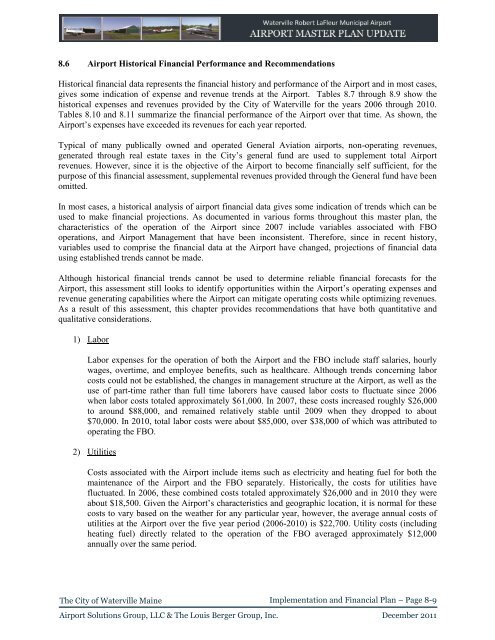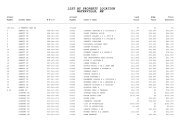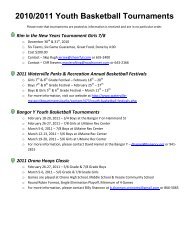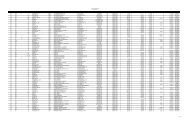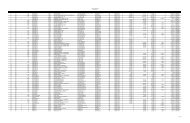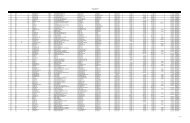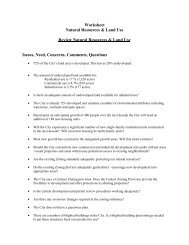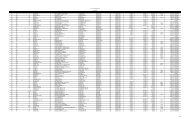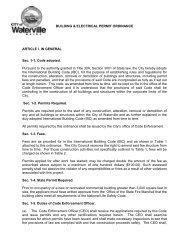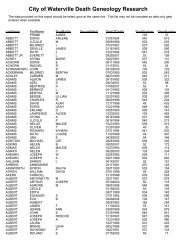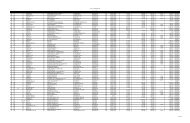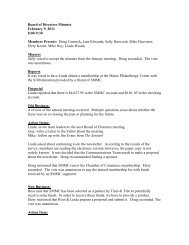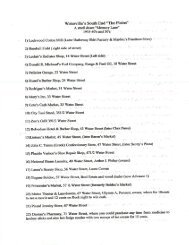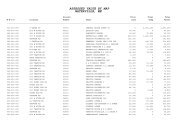Airport Master Plan 2012 - City of Waterville
Airport Master Plan 2012 - City of Waterville
Airport Master Plan 2012 - City of Waterville
You also want an ePaper? Increase the reach of your titles
YUMPU automatically turns print PDFs into web optimized ePapers that Google loves.
8.6 <strong>Airport</strong> Historical Financial Performance and Recommendations<br />
Historical financial data represents the financial history and performance <strong>of</strong> the <strong>Airport</strong> and in most cases,<br />
gives some indication <strong>of</strong> expense and revenue trends at the <strong>Airport</strong>. Tables 8.7 through 8.9 show the<br />
historical expenses and revenues provided by the <strong>City</strong> <strong>of</strong> <strong>Waterville</strong> for the years 2006 through 2010.<br />
Tables 8.10 and 8.11 summarize the financial performance <strong>of</strong> the <strong>Airport</strong> over that time. As shown, the<br />
<strong>Airport</strong>’s expenses have exceeded its revenues for each year reported.<br />
Typical <strong>of</strong> many publically owned and operated General Aviation airports, non-operating revenues,<br />
generated through real estate taxes in the <strong>City</strong>’s general fund are used to supplement total <strong>Airport</strong><br />
revenues. However, since it is the objective <strong>of</strong> the <strong>Airport</strong> to become financially self sufficient, for the<br />
purpose <strong>of</strong> this financial assessment, supplemental revenues provided through the General fund have been<br />
omitted.<br />
In most cases, a historical analysis <strong>of</strong> airport financial data gives some indication <strong>of</strong> trends which can be<br />
used to make financial projections. As documented in various forms throughout this master plan, the<br />
characteristics <strong>of</strong> the operation <strong>of</strong> the <strong>Airport</strong> since 2007 include variables associated with FBO<br />
operations, and <strong>Airport</strong> Management that have been inconsistent. Therefore, since in recent history,<br />
variables used to comprise the financial data at the <strong>Airport</strong> have changed, projections <strong>of</strong> financial data<br />
using established trends cannot be made.<br />
Although historical financial trends cannot be used to determine reliable financial forecasts for the<br />
<strong>Airport</strong>, this assessment still looks to identify opportunities within the <strong>Airport</strong>’s operating expenses and<br />
revenue generating capabilities where the <strong>Airport</strong> can mitigate operating costs while optimizing revenues.<br />
As a result <strong>of</strong> this assessment, this chapter provides recommendations that have both quantitative and<br />
qualitative considerations.<br />
1) Labor<br />
Labor expenses for the operation <strong>of</strong> both the <strong>Airport</strong> and the FBO include staff salaries, hourly<br />
wages, overtime, and employee benefits, such as healthcare. Although trends concerning labor<br />
costs could not be established, the changes in management structure at the <strong>Airport</strong>, as well as the<br />
use <strong>of</strong> part-time rather than full time laborers have caused labor costs to fluctuate since 2006<br />
when labor costs totaled approximately $61,000. In 2007, these costs increased roughly $26,000<br />
to around $88,000, and remained relatively stable until 2009 when they dropped to about<br />
$70,000. In 2010, total labor costs were about $85,000, over $38,000 <strong>of</strong> which was attributed to<br />
operating the FBO.<br />
2) Utilities<br />
Costs associated with the <strong>Airport</strong> include items such as electricity and heating fuel for both the<br />
maintenance <strong>of</strong> the <strong>Airport</strong> and the FBO separately. Historically, the costs for utilities have<br />
fluctuated. In 2006, these combined costs totaled approximately $26,000 and in 2010 they were<br />
about $18,500. Given the <strong>Airport</strong>’s characteristics and geographic location, it is normal for these<br />
costs to vary based on the weather for any particular year, however, the average annual costs <strong>of</strong><br />
utilities at the <strong>Airport</strong> over the five year period (2006-2010) is $22,700. Utility costs (including<br />
heating fuel) directly related to the operation <strong>of</strong> the FBO averaged approximately $12,000<br />
annually over the same period.<br />
The <strong>City</strong> <strong>of</strong> <strong>Waterville</strong> Maine<br />
Implementation and Financial <strong>Plan</strong> – Page 8-9<br />
<strong>Airport</strong> Solutions Group, LLC & The Louis Berger Group, Inc. December 2011


